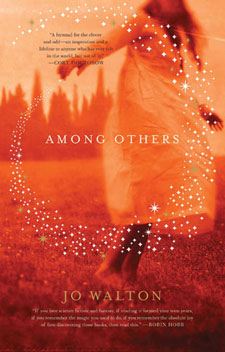Read This: Among Others
 Yesterday, Shelf Awareness ran my review of Jo Walton’s Among Others, a novel that masterfully blurs the lines between “fantasy” and “literary” fiction, and between “adult” and “YA” novels, in a beautifully compelling story about a teenage girl who has trouble getting along with anybody else at her boarding school and spends most of her time reading science fiction and fantasy novels.
Yesterday, Shelf Awareness ran my review of Jo Walton’s Among Others, a novel that masterfully blurs the lines between “fantasy” and “literary” fiction, and between “adult” and “YA” novels, in a beautifully compelling story about a teenage girl who has trouble getting along with anybody else at her boarding school and spends most of her time reading science fiction and fantasy novels.
OK, that’s a deliberately glib description. Morwenna Phelps is a teenage girl, and she has been sent to a boarding school after a family tragedy, and she is a huge SF/F fan—with definite tastes that will be instantly recognizable to any fan who came of age around 1979, when this novel is set. (My own science fiction awakening began in earnest about five years later, and though it didn’t follow the exact trajectory Mori’s does, the terrain is intimately familiar.) But the references to Heinlein and Tolkien and Zelazny aren’t so in-jokey that people with no background in the genres can’t follow along, and in any case the core of the novel isn’t “Mori reads the classics” but “Mori struggles to make sense of this massive trauma that took place offstage, just before our story kicks into gear.” And, as Cory Doctorow notes in his review, “these books are not an escape for her… [but] a whole cognitive and philosophical toolkit for unpicking the world, making sense of its inexplicable moving parts, from people to institutions. This isn’t escapism, it’s discovery.”
Doctorow embraces the fantasy elements of the novel quite readily in his review, but I’m a bit more skeptical—and I think one of Walton’s most brilliant achievements here is that, by telling the story through Mori’s perspective, she makes it possible for both readings to be correct, with the reader being forced to choose which one to believe. In my review, I compared Among Others to another possibly magical story about a teenage girl, Frank Portman’s Andromeda Klein; both novels reinforce a point I’ve made over and over here: If your story is good enough and true enough to its own internal compass, you can put it on any superficially appropriate shelf in the bookstore and the right readers will discover it.
19 January 2011 | read this |

 Our Endless and Proper Work is my new book with Belt Publishing about starting (and sticking to) a productive writing practice.
Our Endless and Proper Work is my new book with Belt Publishing about starting (and sticking to) a productive writing practice. 
